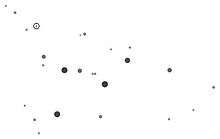Nu Cassiopeiae
| Observation data Epoch J2000.0 Equinox J2000.0 | |
|---|---|
| Constellation | Cassiopeia |
| Right ascension | 00h 48m 50.022s[1] |
| Declination | +50° 58′ 05.40″[1] |
| Apparent magnitude (V) | +4.90 |
| Characteristics | |
| Spectral type | B9III |
| U−B color index | −0.42 |
| B−V color index | −0.11 |
| Variable type | none |
| Astrometry | |
| Radial velocity (Rv) | +009 km/s |
| Proper motion (μ) | RA: 30.84 ± 0.22[1] mas/yr Dec.: −10.02 ± 0.18[1] mas/yr |
| Parallax (π) | 7.92 ± 0.32[1] mas |
| Distance | 410 ± 20 ly (126 ± 5 pc) |
| Absolute magnitude (MV) | −0.48 |
| Other designations | |

Map of the Bayer-designated stars in Cassiopeia. Nu Cassiopeiae is circled.
Nu Cassiopeiae (ν Cas, ν Cassiopeiae) is a star in the constellation Cassiopeia. ν Cassiopeiae is a blue-white B-type giant with an apparent magnitude of +4.90. It is approximately 410 light years from Earth.[1]
References
- 1 2 3 4 5 6 van Leeuwen, F. (2007). "Validation of the new Hipparcos reduction". Astronomy and Astrophysics. 474 (2): 653–664. arXiv:0708.1752
 . Bibcode:2007A&A...474..653V. doi:10.1051/0004-6361:20078357.Vizier catalog entry
. Bibcode:2007A&A...474..653V. doi:10.1051/0004-6361:20078357.Vizier catalog entry
This article is issued from Wikipedia - version of the 4/17/2016. The text is available under the Creative Commons Attribution/Share Alike but additional terms may apply for the media files.